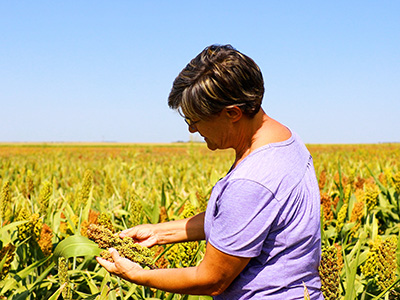At the 2025 Water for Food Conference hosted by DWFI, a panel discussion titled "View from the Field" brought together agricultural industry experts to discuss the future of farming, with a particular focus on agricultural resilience both in and outside of the United States. The conference, held in Lincoln, Nebraska, centered on the theme “a resilient future: water and food for all” and the discussions reinforced lessons learned from previous research I’ve done on agricultural resilience.
One of topics explored in the panel was how to ensure that the agriculture sector can thrive as weather patterns, demographics, and technology change. All panelists talked about the importance of attracting younger generations into farming and ranching. They also touched on opportunities offered by modern technology to enhance agricultural resilience. These are issues and questions that the agricultural community is grappling with, especially as challenges such as water scarcity, soil degradation, and economic constraints become more pronounced.
The theme of resilience—producers’ and other agricultural actors’ ability to endure and adapt to weather challenges—emerged as a central focus. Resilience doesn’t just mean the ability to weather a drought or flood; it encompasses a broader commitment to ensuring that farms can continue to feed communities in the face of changing climate conditions, new technologies, and shifting economic landscapes.
Building Resilience: A Proactive Approach

A central takeaway from the "View from the Field" segment was the importance of proactive measures in agriculture, a theme that has been a focus of past DWFI research. Tracy Zink, who was also a panelist at the “View from the Field” segment, is a producer from southwest Nebraska. She provided an insightful perspective on resilience, emphasizing the need for sustainability and adaptability in farm operations. I met Tracy for the first time as a researcher working on a fact-finding project on agricultural resilience, along with several others in the agriculture industry of whom I will introduce throughout this blog. As Tracy puts it, “sustainability means that I can continue farming while balancing inputs, production costs, and conservation practices. It’s about keeping what we have here in a productive, resilient condition—not just for today, but for the future.”
Zink’s operation exemplifies how farmers are embracing technology to maintain resilience. Juliann Salinas, another participant in our fact-finding project and the executive director of the Women, Food and Agriculture Network (WFAN), takes this further by emphasizing that there is potential to leverage new approaches to make agricultural systems more accessible and inclusive, opening doors for women and minority farmers. Salinas highlighted that these groups “are responsible for a significant portion of land stewardship in the United States and are often the early adopters of new technology and resilient farming practices.” WFAN's approach underscores the importance of peer-to-peer support in enhancing resilience . Through their programs, participants can share knowledge, access resources, and collaborate to implement innovative, ecologically-friendly practices. As Salinas explains, participants in their programming "keep agricultural resilience top of mind in their land management decision-making."
Technology Adoption: The Key to Resilience
Technology has become a major tool for producers trying to stay ahead. They are increasingly turning to innovations like precision irrigation, crop management software, and data-driven decision-making tools to optimize their operations. As Zink notes referring her advanced crop and irrigation management system, "I would not be nearly as successful today if I didn’t have some of the technology at my fingertips. Education and staying flexible to change are key."
While the potential for technology to improve farm resilience is enormous, the adoption of these tools can be a barrier for some producers. The cost of new technology can be prohibitive, especially for smaller operations or new entrants into the farming industry. This issue was highlighted by Jessica Groskopf, director of the Nebraska Women in Agriculture program, who noted that, “The adoption of new practices can be very expensive. We see that many of our producers need a better understanding of crop insurance and other programs that can help mitigate the costs of adopting new technologies.”
A rancher I spoke with during my fact-finding project also shared how, upon taking over the family ranch, she enrolled in an insurance program her family had not previously considered. She went on to note that they had already received payouts from that program, emphasizing the importance of staying informed about new tools to manage risks in any operation.
Financial barriers to technology adoption are not limited to equipment costs alone. Credit constraints and the challenge of accessing land are often cited as major hurdles. Groskopf adds, “Access to land is the number one challenge for new and beginning producers. The financial support and programs available to help farmers manage those challenges are essential to building resilience.”
Overcoming Financial Constraints and Land Accessibility
Credit access and land ownership remain significant issues for many in the farming community. Although women and minority farmers own nearly half of all U.S. farmland, they still face barriers to acquiring land or securing financing to adopt new practices. This gap in approachability can limit the long-term resilience of farming operations, particularly when producers are not able to make necessary investments in technology, equipment, or infrastructure that mitigate climate risks.
Land accessibility is crucial for younger generations looking to enter the agricultural sector. Aspiring producers cannot build resilient, profitable operations if they cannot buy or lease land. One landowner I spoke with talked of concerns about approaching their tenants with ideas for better land management practices to ensure the long-term health of the soil. The landowner found that some traditional producers resisted new practices, even though these practices help the environment and do not affect profitability. On the other hand, some forward-looking producers can’t implement new practices because they lack access to land or capital.
As Groskopf said, “When you talk to any new and beginning producer, that’s going to be the number one thing they discuss—access to land. It is a huge challenge for anyone entering the business, and that is especially true in a changing climate.” This issue was also mentioned by Zink in the conference panel discussion, where she pointed out that the freedom to make on-farm decisions is largely dependent on land ownership.
The Path Forward: Collaboration, Education, and Innovation

To enhance resilience, collaboration and knowledge-sharing between farmers and industry stakeholders will be key. Producers I spoke with have shown how staying engaged with new research, adopting technology, and staying flexible in the face of challenges can lead to more success in farming practices. However, for these solutions to have the widest impact, agricultural producers need access to affordable resources, education, and financial support.
Resilience as the Foundation for Food Security
The lessons learned from the conference panel discussion and conversations with farmers like Zink, Salinas, and Groskopf remind us that resilience is not just about surviving the next drought—it’s about ensuring the long-term health and profitability of agricultural systems. Farming is evolving. With the right support, education, and technological innovation, the next generation of farmers can be better equipped to feed the world while safeguarding natural resources for the future.
Acknowledgement
The fact-finding project on agriculture resilience described in this article was supported in part by the U.S. Department of Agriculture (USDA), Office of the Chief Economist (OCE) during the 2024-2025 support cycle. The findings and conclusions in this article are those of the author and should not be construed to represent any official USDA or U.S. Government determination or policy.


